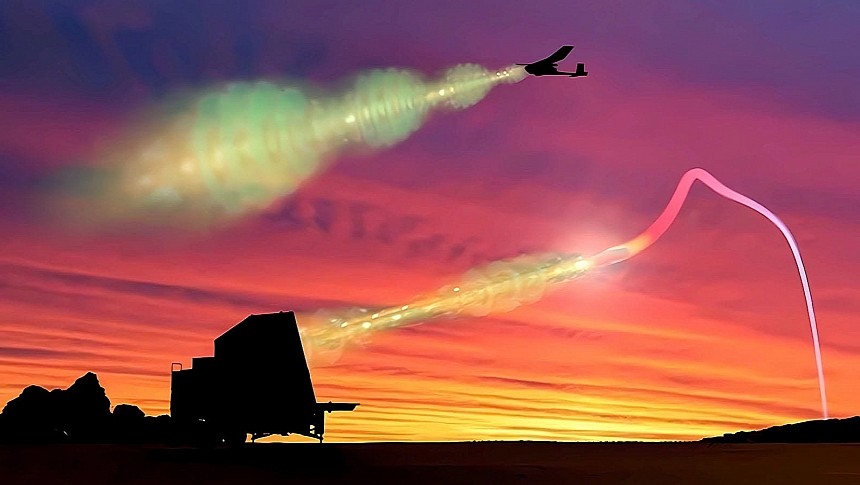Our species' way of conducting warfare is largely based on kinetic energy. What that means is that most of our weapons are centered around projectiles traveling fast to hit their targets. That's the case for anything from bullets to ICBMs.
The vast majority of interceptors are kinetic-based as well. A defending force will shoot a projectile at an incoming threat (be it a missile, a drone, or an aircraft) in the hopes of inflicting enough damage to neutralize it.
But there is a push now to develop non-kinetic interceptors. By that the militaries of the world are imagining energy weapons that can not only be more effective than projectiles, but also cheaper and easier to make and use.
Work on such concepts is ongoing all over the world, and the shapes they take vary from lasers to electromagnetic pulse generators. This story however is about a microwave weapon being developed in the U.S.
Not long ago the U.S. military kicked off something called the Directed Energy Front-line Electromagnetic Neutralization and Defeat program. DEFEND for short, it aims at securing high-power microwave (HPM) weapons for the U.S. Navy and U.S. Air Force (USAF).
The program aims to award a contract for such a system in the fourth quarter of this year, so every company involved is rushing to prove what they can do. For defense contractor Raytheon, that meant putting something called CHIMERA to a very long test.
CHIMERA is an acronym for Counter-Electronic High-Power Microwave Extended-Range Air Base Defense and it's technically an antenna. It is used to shoot directed energy (in this case highly concentrated radio energy) at selected targets.
The system is in an advanced stage of development, as it just completed a three-week field test at the White Sands Missile Range in New Mexico. And it was a successful run, if we are to judge by what Raytheon is telling us.
As per the few details released this week, CHIMERA was used to fire "directed energy to multiple static target variations." What that means is that multiple middle-to-long-range targets were engaged and shot with energy traveling at the speed of light.
The tests were also meant to prove the end-to-end fire control capabilities of the system, meaning from the acquisition and tracking of the target to their destruction.
The exact capabilities of the CHIMERA system are not known, other than the fact that this "ground-based demonstration system wields more power than other HPM systems."
The test moves the project one closer to completion, but there is still no official timetable for when the weapons is likely to be deployed on the front lines. One thing is certain though: once this thing is fielded, even the most sophisticated of enemy weapons will have something nearly unbeatable to fear.
But there is a push now to develop non-kinetic interceptors. By that the militaries of the world are imagining energy weapons that can not only be more effective than projectiles, but also cheaper and easier to make and use.
Work on such concepts is ongoing all over the world, and the shapes they take vary from lasers to electromagnetic pulse generators. This story however is about a microwave weapon being developed in the U.S.
Not long ago the U.S. military kicked off something called the Directed Energy Front-line Electromagnetic Neutralization and Defeat program. DEFEND for short, it aims at securing high-power microwave (HPM) weapons for the U.S. Navy and U.S. Air Force (USAF).
The program aims to award a contract for such a system in the fourth quarter of this year, so every company involved is rushing to prove what they can do. For defense contractor Raytheon, that meant putting something called CHIMERA to a very long test.
CHIMERA is an acronym for Counter-Electronic High-Power Microwave Extended-Range Air Base Defense and it's technically an antenna. It is used to shoot directed energy (in this case highly concentrated radio energy) at selected targets.
The system is in an advanced stage of development, as it just completed a three-week field test at the White Sands Missile Range in New Mexico. And it was a successful run, if we are to judge by what Raytheon is telling us.
As per the few details released this week, CHIMERA was used to fire "directed energy to multiple static target variations." What that means is that multiple middle-to-long-range targets were engaged and shot with energy traveling at the speed of light.
The tests were also meant to prove the end-to-end fire control capabilities of the system, meaning from the acquisition and tracking of the target to their destruction.
The exact capabilities of the CHIMERA system are not known, other than the fact that this "ground-based demonstration system wields more power than other HPM systems."
The test moves the project one closer to completion, but there is still no official timetable for when the weapons is likely to be deployed on the front lines. One thing is certain though: once this thing is fielded, even the most sophisticated of enemy weapons will have something nearly unbeatable to fear.








